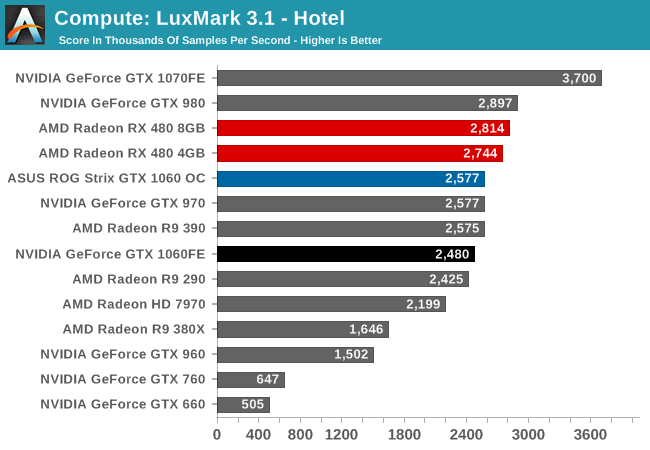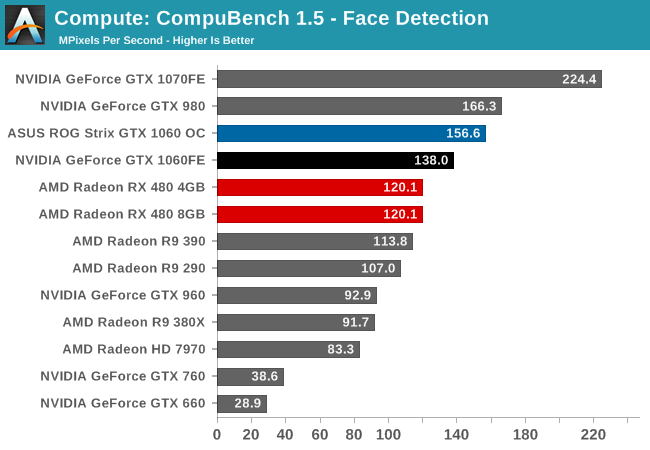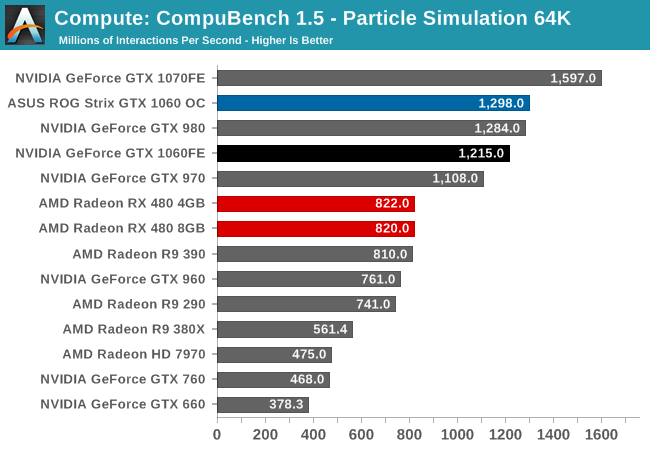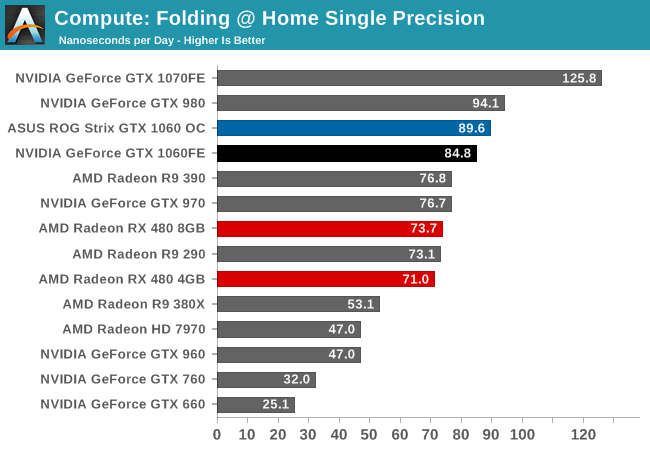The GeForce GTX 1060 Founders Edition & ASUS Strix GTX 1060 Review
by Ryan Smith on August 5, 2016 2:00 PM ESTCompute
Shifting gears, let’s take a look at compute performance on GTX 1060.
As we already had the chance to categorize the Pascal architecture’s compute performance in our GTX 1080 review, there shouldn’t be any surprises here. But it will be interesting to see whether the GTX 1060’s higher ratio of memory bandwidth per FLOP materially impacts overall compute performance.
Starting us off for our look at compute is LuxMark3.1, the latest version of the official benchmark of LuxRender. LuxRender’s GPU-accelerated rendering mode is an OpenCL based ray tracer that forms a part of the larger LuxRender suite. Ray tracing has become a stronghold for GPUs in recent years as ray tracing maps well to GPU pipelines, allowing artists to render scenes much more quickly than with CPUs alone.

While GTX 1060 could hang with GTX 980 in gaming benchmarks, we don’t start off the same way with compute benchmarks, with the last-generation flagship holding about 17% ahead. Unfortunately for NVIDIA, this is about where GTX 1060 needed to be to best RX 480; instead it ends up trailing the AMD competition. Otherwise the performance gain versus the GTX 960 stands at 65%.
For our second set of compute benchmarks we have CompuBench 1.5, the successor to CLBenchmark. CompuBench offers a wide array of different practical compute workloads, and we’ve decided to focus on face detection, optical flow modeling, and particle simulations.



Like with GTX 1080, relative performance is all over the place. GTX 1060 wins with face detection, loses at optical flow, and wins again at particle simulation. Even the gains versus GTX 960 are a bit more uneven, though at the end of the day GTX 1060 ends up being significantly faster than its predecessor with all 3 sub-benchmarks.
Moving on, our 3rd compute benchmark is the next generation release of FAHBench, the official Folding @ Home benchmark. Folding @ Home is the popular Stanford-backed research and distributed computing initiative that has work distributed to millions of volunteer computers over the internet, each of which is responsible for a tiny slice of a protein folding simulation. FAHBench can test both single precision and double precision floating point performance, with single precision being the most useful metric for most consumer cards due to their low double precision performance. Each precision has two modes, explicit and implicit, the difference being whether water atoms are included in the simulation, which adds quite a bit of work and overhead. This is another OpenCL test, utilizing the OpenCL path for FAHCore 21.


Finally, in Folding@Home, we see the usual split between single precision and double precision performance. GTX 1060 is solidly in the lead when using FP32, but NVIDIA’s poor FP64 rate means that if double precision is needed, RX 480 will pull ahead.










189 Comments
View All Comments
fanofanand - Saturday, August 6, 2016 - link
You keep saying that but there are no 1060s that can be bought for $249. MSRP is meaningless when none sell at that price.eddman - Saturday, August 6, 2016 - link
...and you keep at it as if it isn't the same with 480s. I just looked for 8GB 480s on newegg. All out-of-stock except for one model that is going for $400!!!I suppose you've never heard of shortages. There are $250 1060s. They simply sell as soon as they get restocked.
Dr. Swag - Friday, August 5, 2016 - link
Any word on the progress of the rx 480 review? I haven't seen any good dives on the Polaris architecture so I'm really stoked on your review!Ryan Smith - Friday, August 5, 2016 - link
I want to do a bit more on the Polaris architecture, but it will have to wait until after RX 470 and RX 460.Dr. Swag - Friday, August 5, 2016 - link
Ah OK. Thanks for the response!xenol - Friday, August 5, 2016 - link
Anyone else chuckle at the heatsinks past the fan that apparently aren't attached to anything?DanNeely - Friday, August 5, 2016 - link
Yeah those stubs are cosmetic; but there's not much to them either.Tom's has a detailed teardown of the cooler. A few ornamental fins on the front edge with the entire actual heatsink between the blower and case exhaust holes. The 1080's is about the same.
http://www.tomshardware.com/reviews/nvidia-geforce...
http://www.tomshardware.com/reviews/nvidia-geforce...
tipoo - Friday, August 5, 2016 - link
Pretty funny, main heatsink comes off and that little heatsink nub remains. Maybe it manipulates airflow to the fan, at most? Or, more likely, it's just cosmetic to make this look like a bigger GPU.Mr Perfect - Friday, August 5, 2016 - link
When you inevitably do a custom card round up, could you please get some blower style fully exhausting cards in there? It would be immensely helpful for the SFF crowd who can't stuff a tipple fan behemoth in the case, much less dump 120 watts of heat in there. Off hand, Asus has the Turbo, Gainward has one and Galax has another.fanofanand - Friday, August 5, 2016 - link
When was the last time Anandtech did a custom card roundup? They don't really do that sort of thing anymore.